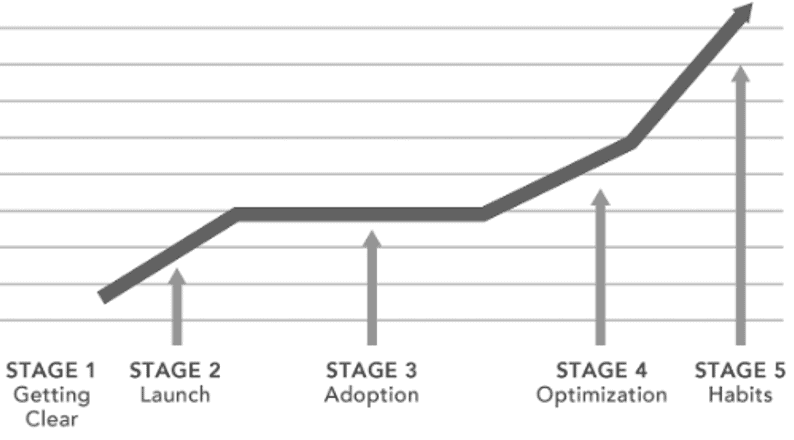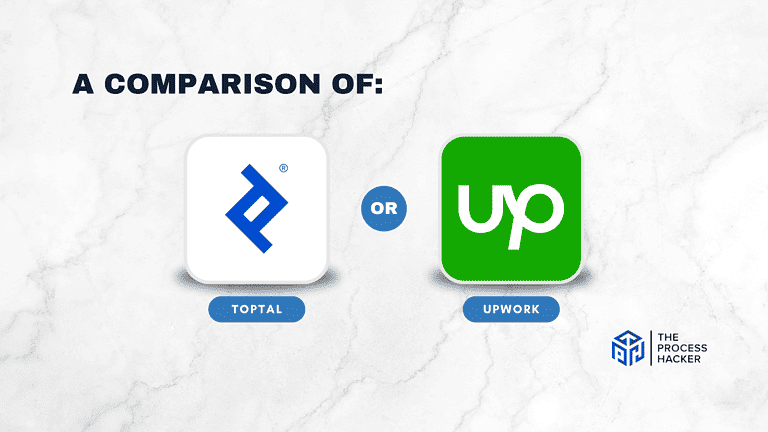The 4 Disciplines of Execution | Book Summary
The 4 Disciplines of Execution: Achieving Your Wildly Important Goals (4DX) provides a simple, repeatable, and proven method for executing your most critical strategic priorities amid your day-to-day work. The book is authored by Chris McChesney, Sean Covey, and Jim Huling, with Scott Thele and Beverly Walker, and it is recognized as one of the most influential business books, offering actionable guidance for leaders and organizations aiming to achieve substantial success.
The 4 Disciplines of Execution Summary below helps you take exceptional execution to achieve your wildly important goals.
Buy The 4 Disciplines of Execution on Amazon
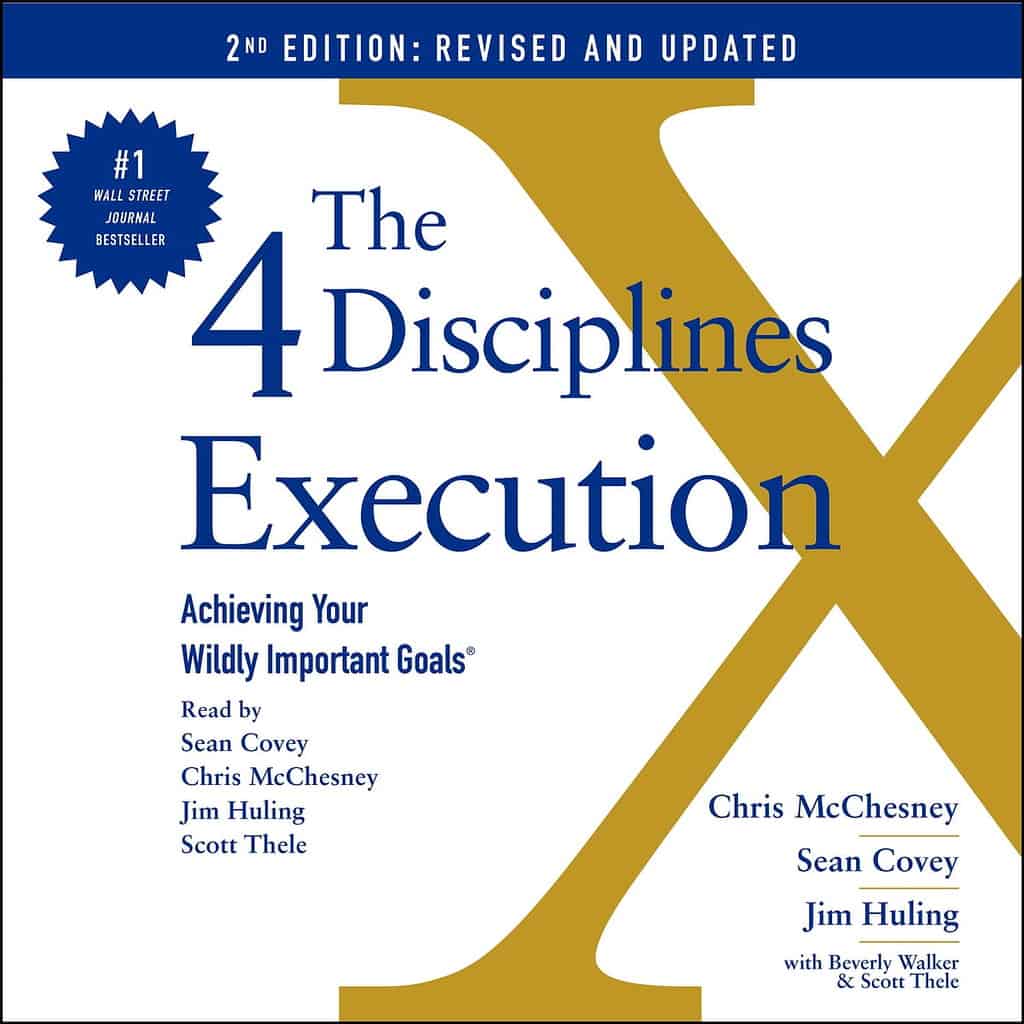
The 4 Disciplines of Execution by Chris McChesney, Sean Covey, and Jim Huling
Achieving Your Wildly Important Goals
In general, leaders can produce results using the following methods:
- Strategy (or Plan) – “a plan or method for achieving the mission of the organization or team”
- Execution (of the Strategy) – “the discipline of getting things done as promised—on time, on budget, and with quality”
Leaders struggle more with executing a strategy, which makes sense as most business education focuses on creating a strategy. However, the most significant challenge after figuring out what to do is to get your people to do it with excellence.
- Part 1 – Learning The 4 Disciplines Of Execution (4DX)
- Part 2: Applying The 4 Disciplines Of Execution (4DX) As A Leader Of Leaders
- Part 3: Applying the 4 Disciplines of Execution (4DX) as a Leader of a Frontline Team
- Chapter 11 – What to Expect with the 4 Disciplines of Execution
- Chapter 12 – Applying Discipline 1: Focus On The Wildly Important
- Chapter 13 – Applying Discipline 2: Act on the Lead Measures
- Chapter 14 – Applying Discipline 3: Keep A Compelling Scoreboard
- Chapter 15 – Applying Discipline 4: Create A Cadence Of Accountability
- Conclusion and Next Steps
Download the PDF Book Summary for The 4 Disciplines of Execution
Part 1 – Learning The 4 Disciplines Of Execution (4DX)
The first part of The 4 Disciplines of Execution describes how the concepts work and why discipline focuses people to meet the goals and challenges of leadership.
Chapter 1 – The Real Problem With Execution
Executing a strategy that requires people to change their behavior is one of the most challenging leadership problems to solve. The solution is to use the 4 Disciplines of Execution, which is a proven set of practices for successful execution.
There are two initiatives for senior leaders to drive results within teams or organizations:
- Stroke-of-the-Pen Strategy – “a strategy that leaders execute just by ordering or authorizing it to be done and that generally does not require a lot of people to do things differently”
- Breakthrough Strategy – “a strategy that requires people—sometimes many people—to do things that are new and different”
The Stoke-of-the-Pen Strategy simply requires resources or authority, while the Breakthrough Strategy requires changing personnel behavior. Thus, you need to execute using the latter strategy to achieve results, but to do so will require battling the whirlwind:
Whirlwind – “the enormous amount of time and energy required to keep the organization at its current level of performance”
However, most leaders do not distinguish between the Whirlwind and strategic goals. The Breakthrough Strategy works “on” your organization by taking high-level actions, while the Whirlwind works “in” by dealing with urgent activities, which is shown in the diagram below:
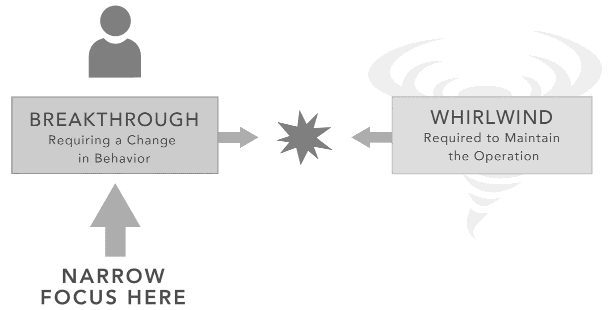
Source: The 4 Disciplines of Execution (4DX)
This book provides the 4 Disciplines of Execution for accomplishing breakthrough results on your strategic goals:
4 Disciplines of Execution (4DX) – “an orderly pattern of conduct that leads to the achievement of an organizational goal with excellence; the 4 Disciplines are based on deep research and fieldwork, as well as fundamental principles of human behavior:”
- Focus on the Wildly Important
- Act on the Lead Measures
- Keep a Compelling Scoreboard
- Create a Cadence of Accountability
When using the behavioral change strategy, people typically fall into one of these groups:
- Models – the people that are open to new ideas and actively adapt the new behaviors
- Not Yets – the largest group that appears supportive but does not engage immediately
- Nevers – the people that do not partake and engage in the required behavior changes
There are three things to be aware of when learning the Four Disciplines:
- 4DX says easy, does hard. The disciplines seem simple but require work to implement.
- 4DX is counterintuitive. The disciplines are paradigm shifts going against your intuition.
- 4DX is an operating system. The disciplines work together sequentially to be effective.
Chapter 2 – Discipline 1: Focus On The Wildly Important
Exceptional execution starts by focusing on The One Thing (book summary) to achieve more.
Discipline 1 For The Leader Of A Frontline Team
Discipline 1: Focus on the Wildly Important: “The practice of defining crucial goals and narrowing the team’s focus to those goals. Work teams who practice Discipline 1 are totally clear on a few WIGs and the lag measures for those goals.”
The first discipline starts by selecting your one objective or Wildly Important Goal:
Wildly Important Goal (WIG) – “a goal essential to carrying out the organization’s mission or strategy; failure to achieve this goal will render all other achievements secondary”
After defining the WIG, work should be sorted into these two categories using the 80/20 Rule:
- Whirlwind – the day-to-day needed to be done, which requires 80% of time and energy
- WIG – the one outcome to achieve the breakthrough, which requires the remaining 20%
Instead of trying to do it all, WIGs clearly show the team its importance so that team members can focus. These guidelines help narrow to one WIG:
- Think from the team perspective such that every team member is only focusing on one WIG.
- Avoid choosing a WIG that encapsulates your whole workload.
Leaders are under pressure to create more goals instead of narrowing their focus. Thus, their most significant challenge is saying no to many good ideas. Therefore, when defining a Team WIG, leaders face one of two scenarios:
- You have goal-setting autonomy. Ask yourself, “If every other aspect of our team’s performance remained at its current level, what is one area where significant improvement would have the greatest impact?”
- You do not have goal-setting autonomy. Ask yourself, “What improved outcome would represent our team’s greatest contribution to the overall strategy?”
Discipline 1 For Leaders Of Leaders
Leaders of leaders face these common focus traps:
- Having trouble saying no to good ideas. Saying no to good ideas allows you to focus on a few great ideas, which leads to extraordinary results.
- Trying to turn everything in the whirlwind into a WIG. This trap consumes all your time as you try to improve every aspect of your whirlwind.
- Trying to create a WIG by identifying the most critical objective. Instead, ask, “Where do we most want to create a breakthrough?”
Instead, avoid these traps by directing the energy of the WIG toward an outcome by:
- Guiding frontline leaders to define Team WIGs to get a breakthrough for the team.
- Having multiple teams focus on achieving their Team WIG every week along with their whirlwind.
- Direct the collective energy of the teams as “breakthrough currency” that can be spent.
There are three common approaches you can use to define WIGs at your level:
- Create a single Primary WIG. The Primary WIG directs the energy in the organization to produce the greatest possible impact, with everyone contributing to the outcome.
- Create a small set of Primary WIGs. Allows frontline teams to “align their Team WIG to the one Primary WIG where they can make the greatest contribution and impact.”
- Give leaders of frontline teams autonomy to choose their own Team WIG. Then, these leaders use their judgment to create a Team WIG to be most effective.
This diagram shows how smart teams can align their team WIGs to a Sub-WIG (Battle) at an intermediate level or the Primary WIG at the highest level:
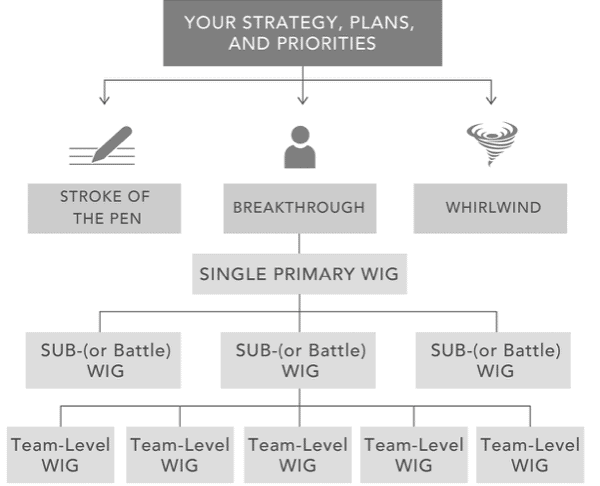
Source: The 4 Disciplines of Execution (4DX)
Rules: These four primary rules allow leaders of leaders to apply Discipline 1 successfully within an organization:
- No individual focuses on more than one WIG at a time. This rule provides focus and prevents overloading any single leader, team, or individual.
- The battles you choose must win the war. After selecting the Primary WIG, identify the fewest number of battles necessary to win the war:
- Battle – “an enabling or supporting WIG owned by a lower-level team”
- War – the Primary WIG or “highest-level organizational WIG”
- Leaders of leaders can veto but not dictate. Even though senior leaders choose the Primary WIG, they must allow frontline leaders to primarily define their Team WIG.
- All WIGS must have a finish line in the form of “From X to Y by When.” This framework defines every WIG into a measurable result that must be achieved by a specific date.
Chapter 3 – Discipline 2: Act On The Lead Measures
The second discipline leverages the least actions that have the most significant impact on achieving WIGs:
Discipline 2: Act on the Lead Measures: “The practice of consistently carrying out and tracking results on those high-leverage activities that will lead to the achievement of WIGs. Work teams who practice Discipline 2 are clear on the lead measures of their goals and track them carefully.”
This chart illustrates the relationship between the measures with the lead measures influencing the lead measures for the strategy to achieve the Primary WIG:
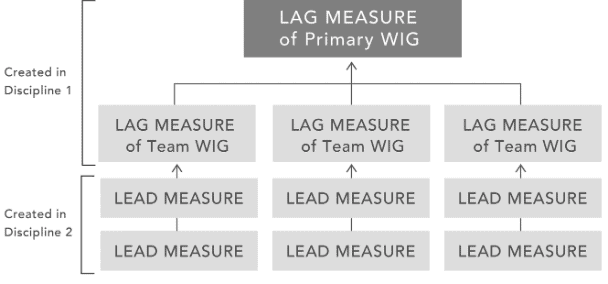
Source: The 4 Disciplines of Execution (4DX)
Lag Measures
From Discipline 1, every team owns a Team WIG that is aligned to the Primary WIG, both for which progress can be measured in terms of the lag measure:
Lag Measure – “the measure of goal or WIG achievement:”
- Easy to measure but difficult for an individual or team to influence directly.
- Expressed using From X to Y by When – “tracking movement from a current X to a better or more desirable Y within a certain time frame”
- Track past performance in terms of profit, revenue, customer satisfaction, etc.
Lead Measures
Almost all leaders focus on the lag measures, which easily indicate whether success has been achieved. However, teams should identify and act on the lead measures or KPIs with the highest leverage for their Team WIG:
Lead Measure – “the measure of an action planned and taken as a means to achieving a WIG:”
- Predictive – “measures something that leads to the goal”
- Influenceable – affects the actions that you have control over that produces outcomes
- Leverage by executing on the highest-leverage actions to achieve the WIG.
- Constitute the team’s Strategic Bet – “the hypothesis that certain high-leverage activities will drive the achievement of a goal, which is proven through execution”
A good lead measure allows your team to improve the effectiveness of their actions using the 80/20 Rule. You should choose the 20 percent of highest-leverage actions that will have the 80 percent of disproportionate impact for achieving your WIG.
Chapter 4 – Discipline 3: Keep A Compelling Scoreboard
The third discipline ensures that everyone knows the score and whether they are winning:
Discipline 3: Keep a Compelling Scoreboard: “The practice of visibly tracking key success measures on a goal. Work teams who practice Discipline 3 are continually preoccupied with moving the measures on the scoreboard.”
“People play differently when they are keeping score.” When team members take responsibility for keeping score, they understand their performance in the context of achieving their goal. This practice raises the level of play, which causes people to take the 10X actions necessary to win.
Scoreboard
In Discipline 3, execution is captured on the scoreboard:
Scoreboard – “a mechanism for tracking progress on lead and lag measures for a WIG, which should be visible to the entire team and consistently and regularly updated”
The scoreboard impacts team performance in these three ways:
- Provides a visual representation of the team’s strategic bet.
- Indicates to that team that winning is important.
- Provides a counterbalance to the urgency of the whirlwind.
Ask these four questions to determine whether the scoreboard is compelling for the players:
- Is it simple? Display only a few pieces of information necessary to play the game.
- Can I see it easily? Make it very visible to the team to drive accountability.
- Does it show lead and lag measures? The team knows it can affect the lead measures while seeing the desired results in the lag measures.
- Can I tell at a glance if I’m winning? Show within 5 seconds if you are winning or losing.
Using the 4DX framework, you keep your team engaged in achieving the WIG by creating a winnable game. The winnable tendency is orchestrated through the interaction of the lead and lag measures on the scoreboard.
Chapter 5 – Discipline 4: Create A Cadence Of Accountability
The fourth discipline is based on accountability:
Discipline 4: Create a Cadence of Accountability: “The practice of regularly and frequently planning and reporting on activities intended to move the measures on the WIG scoreboard. Work teams who practice Discipline 4 make individual and collective commitments and account for those commitments in weekly WIG Sessions.”
In this discipline, you establish a cadence of accountability:
Cadence of Accountability – “a recurring cycle of planning and accounting for results”
While the first three disciplines set up the game in terms of focus, leverage, and engagement, Discipline 4 is for execution:
Execution – “the ability to achieve a critical goal while living in the midst of a raging whirlwind”
WIG Sessions
The cadence of accountability for executing WIGs is maintained through the WIG Session at least weekly:
WIG Session – “a team meeting held at least weekly to account for commitments, review WIG scoreboards, and plan how to improve the scores on the scoreboards”
Rules: To maintain focus, everyone must follow these three rules for WIG Sessions:
- Hold WIG Sessions weekly on the same day and same time. Consistency is critical to maintaining rhythmic performance.
- The Whirlwind is never allowed into a WIG Session. Discussion should avoid urgent issues and purely focus on the actions that affect lead measures on the scoreboard.
- Standardize WIG Sessions to be twenty to thirty minutes long. Focus on moving the scoreboard to keep sessions efficient and effective.
Agenda: This three-part agenda for a WIG Session is the same regardless of the content:
- Account: Report on last week’s commitments.
- Review: Check the scoreboard and learn from the successes and failures of others.
- Plan: Clear the path and make new commitments.
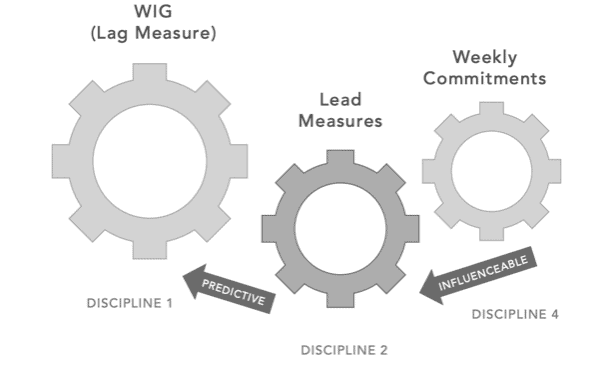
Source: The 4 Disciplines of Execution (4DX)
In the WIG Session, everyone should share accountability for the lead measures on their compelling scorecard and commit to at leads one action that moves the lead measures. Also, the session allows teammates to report on their actions, reflect on what is working, and troubleshoot what is not working. Lastly, team members can help each other solve issues and accomplish an objective by clearing the path:
Clearing the Path – “taking ownership of and resolving a problem or an obstacle to achieving the WIG”
For a different kind of accountability, check out the 4DX app to help you manage using the 4 Disciplines of Execution in your organization and achieving WIGs at all levels.
Download the PDF Book Summary for The 4 Disciplines of Execution
Part 2: Applying The 4 Disciplines Of Execution (4DX) As A Leader Of Leaders
The second part of The 4 Disciplines of Execution shows leaders of leaders how to apply 4DX to address high-level challenges within their organization.
Chapter 6 – Choosing Where To Focus
“The purpose of 4DX is to direct focused energy toward a critical breakthrough.” This chapter of the 4 Disciplines of Execution helps leaders of leaders choose the primary WIG for their organization. Where will you spend your disproportionate energy?
The Strategy Map
Starting from the top-down in the Strategy Map below, most organizations define a Mission:
Mission – “the organization’s or team’s predefined purpose or reason for being”
After defining the mission, the leadership determines the Vision:
Vision – “what success will look like at some point, usually five or more years into the future”
As the mission and vision are aspirational, the leadership creates the strategy to determine how that vision will become a reality. Next, the leadership team should fill in the Stroke-of-the-Pen (left) and Whirlwind (right) parts of your strategy.
These two sections provide clarity and may give the Breakthrough or the Primary WIG (middle), which is shown in the Strategy Map below:
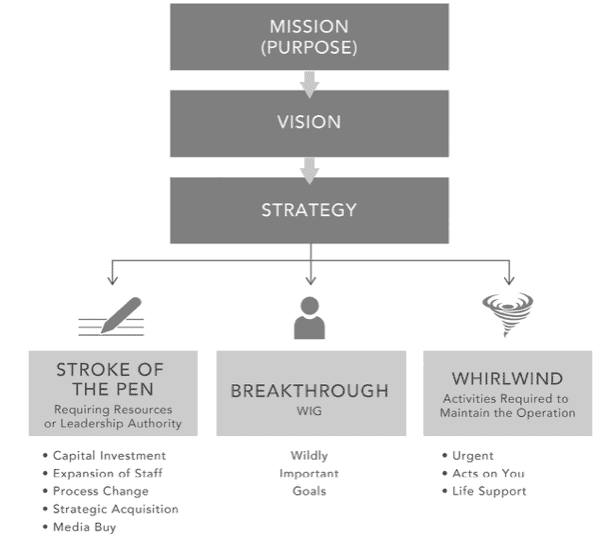
Source: The 4 Disciplines of Execution (4DX)
Identifying Your Breakthrough Result (Primary WIG)
Now, you should brainstorm a list of potential Primary WIGs for the organization by asking: “If every other area of our operation remained at its current level of performance, in which one area would we most want to achieve significant results?”
Note when the right Primary WIG is chosen and completed, it should finally become part of the routine operation in the Whirlwind. Assess the candidate Primary WIGs using these two criteria:
- Impact of Failure: “How mission-critical is the candidate WIG?” Allows you and your team to think about the long-term impact of the Primary WIG failure.
- At Risk of Failure (Without Significant Change): “What is the likelihood that without significantly improved engagement and focus, we will fail at this objective?”
There are four traps that you should avoid when establishing WIGs:
- Creating too many Primary WIGs: 4DX is powerful, so some leaders get tempted to have many WIGs. Instead, worry about having more focus in the Primary WIG.
- Choosing a Primary WIG that is too broad: Some leaders think big and create WIGs that encapsulate every part of the organization. Again, WIGs need to be focused.
- Creating a Primary WIG that is aspirational but not measurable: Some leaders make vague WIGs to induce great effort toward the outcome or include everyone in the WIG.
- Creating Wigs that are not aligned with the mission and vision of the organization. Some leaders can get too focused on the strategy and forget that WIGs are critical but subordinate to the organization’s mission and vision.
Chapter 7 – Translating Organizational Focus Into Executable Targets
This chapter of the 4 Disciplines of Execution shows leaders of leaders how to apply these four rules. When starting the 4DX process, the company can focus by asking: “If every other area of our operation remained at its current level of performance, which one area would we want to improve the most?”
The obvious answer is executing on the Primary WIG to achieve a strategic breakthrough result for the entire organization. Keep in mind the Stroke-of-the-Pen and Whirlwind elements of your strategy, as it will rescope your Primary WIG to apply disciplined 4DX focus on a component.
Key Battles (Sub-Wigs)
Next, with a set Primary WIG, the leaders of leaders can focus on the Key Battles, which are the sub-WIGs to the Primary WIG. The sub-WIGs focus the energy of organizational teams to win. Ask the question: “What is the smallest number of battles necessary to win the war?”
The answer is crucial to translate the Primary WIG into Team WIGs for two reasons:
- Serves as a reminder that Key Battles (sub-WIGs) only exist to achieve the Primary WIG.
- Helps determine the fewest possible Key Battles that are most necessary for success.
Next, write each battle in terms of “From X to Y by When” by answering these two questions:
- What was the highest achievable score for each battle?
- Would these scores add up to winning on the Primary WIG?
If the battles do not lead to victory in the war, your strategy is ineffective, or your game is not winnable. At the team level, each team has a Team WIG that provides focus amongst a team’s day-to-day activities and translates to achieving a battle. Each team’s readiness for execution can be measured by asking:
- Did the team choose a Team WIG that would hugely impact a Key Battle?
- Was achieving the Team WIG a winnable game?
The structure of the Primary WIG and Key Battles should be simple as this will result in successful implementation. Note that the biggest obstacle in execution is not creating a plan but changing the behavior of your people to execute the plan.
Chapter 8 – Getting Your Leaders on Board
This chapter of the 4 Disciplines of Execution describes the mindsets and skills that are most successful in getting your leadership team in alignment with your strategy.
After developing the Primary WIG and Key Battle WIGs, leaders of leaders want to engage their frontline leaders in terms of the following three objectives:
- Finalize the Primary WIG and the Key Battle WIGs. In this top-down process, the leaders of frontline teams should provide input to finalize these WIGs.
- Develop draft Team WIGs for frontline teams. In this bottom-up process, the frontline leaders should create their Team WIGs but get validation from the leaders of leaders.
- Engage the entire leadership team in a committed effort to win. The WIGS should be created and validated at every leadership level to unify leaders in achieving their WIGS.
Leadership Mindsets To Get Alignment And Engagement
Three leadership mindsets are essential for getting alignment and engagement across the leadership team in an organization:
- Transparency Mindset: Allows leaders to contribute their concerns openly, easily recognize that they do not know everything, and actively elicit feedback from others from all levels of the organization.
- Understanding Mindset: Helps leaders to “truly seek to understand the concerns and ideas of the leaders of frontline teams before making a final decision on the Primary WIG and the Key Battle WIGs.”
- Involvement Mindset: Allows leaders of leaders to work in partnership with their frontline leaders. The leaders of frontline teams are entrusted with establishing their Team WIG, which contributed significantly to organizational success.
For more on leadership, check out the 5 Levels of Leadership (book summary) by John Maxwell.
Finalize WIGs At All Levels
There are five steps for applying the mindsets in finalizing WIGs at every organization level:
- Ensure understanding of the Primary WIG and Key Battle WIGs. If you want results, your people should thoroughly understand the WIGS before taking action.
- Respond to clarifying questions. Encourage clarifying questions from your frontline leaders, emphasizing that you are not asking for feedback yet.
- Be open to feedback. The leaders of leaders look to hear and understand feedback from their frontline leaders to improve the Primary and Key Battle WIGs.
- Make a final decision. The leaders of leaders meet without the frontline leaders to finalize the Primary and Key Battle WIGs
- Create Team WIGs. The frontline leaders take responsibility for establishing their Team WIGs such that they align to the Key Battle WIGs.
The creation of WIGs must start from the top-level and translate down each leadership level. Ultimately, the leaders at the bottom level will establish Team WIGs for their frontline teams.
Chapter 9 – Project Execution With The 4 Disciplines Of Execution (4DX)
This chapter of the 4 Disciplines of Execution helps determine if a specific project should be captured as a WIG as well as show you how to achieve it using the 4DX principles:
Project – “a planned undertaking involving defined steps, milestones, and tasks”
Situation 1: The Project Shop
In this situation, a team deals with many projects and is known as a project shop:
Project Shop – “a team whose primary role is the management and completion of projects”
The 4DX discipline should not replace project-management methodology. Instead, “it is a discipline for ensuring your project is successful.”
The 4DX framework should be applied to running all projects. In regard to all their projects, the project shop team should ask, “If everything stayed the same, where do we need to see the most improvement?”
Situation 2: The Project WIG For Non-Project Managers
In this situation, the team runs one project, with running projects not being their primary responsibility. For the project, this is how
- Focus on the Wildly Important: Create a WIG that corresponds to the completion of the project with a specific end date and clear deliverables and outcomes.
- Act on the Lead Measures: Define lead measures in terms of milestones for the project. Effective milestones should ideally be about two to six weeks apart.
- Keep a Compelling Scoreboard: Keep the team focused on the “active” milestones by creating a scoreboard showing them or using the 4DX app.
- Create a Cadence of Accountability: Ask this question to get commitments: “What are the one or two things I can do this week that will ensure we meet our next milestone?”
For more on formulating and achieving projects, check out Start Finishing (book summary) by Charlie Gilkey.
Chapter 10 – Sustaining 4DX Results And Engagement
For additional focus, the authors created the following XPS measure to help leaders of leaders achieve their Primary WIG:
Execution Performance Score (XPS) – “a single indicator that measures not only WIG results but also the habits of execution that drive them” through these four components:
- Establishing a Cadence: “The component indicates how well the team has established a cadence of meeting weekly to focus on the scoreboard. Consistently hold the weekly WIG session, regardless of the urgent demands of the whirlwind.
- Fulfilling High-impact Commitments: This component indicates how well the team has consistently made commitments and followed through. Make “second-level commitments” to work “on the system” and set a high standard for follow-through.
- Optimizing Lead-measures Performance: This component indicates how consistently the lead measures are being performed.” Challenge the lead measures of your frontline teams by asking the following five optimizing questions:
- Is the lead measure directly predictive of impacting the lag measures?
- Is the level of performance set high enough?
- Is the scorekeeping credible?
- Is it a quality problem?
- Is it a team game or a leader’s game?
- Achieving Lag-measure (WIG) Results: This component indicates how effectively the first three components are enabling your team to achieve its WIG.” Hold frontline leaders accountable for performance and results, recognize high performance, and give meaningful feedback.
A higher XPS correlates to better results and a higher likelihood of maintaining and improving your results over time. XPS can be applied to the entire organization, an individual business unit or team, a leadership team, or an individual leader.
Recognizing High Performance
Every team’s performance relies on two fundamental forces:
- Accountability – “the key driver of what people do and how they do it,” which results in “immediate and purposeful action”
- Engagement – “the key driver of why we do what we do,” which “fuels the ability to sustain that performance over the long term”
Accountability is typically present in a team, but engagement is not typical. Instead, you can use genuine recognition by being credible, brief, personal, and authentic.
Download the PDF Book Summary for The 4 Disciplines of Execution
Part 3: Applying the 4 Disciplines of Execution (4DX) as a Leader of a Frontline Team
The third part of The 4 Disciplines of Execution provides frontline leaders with comprehensive instructions for applying the disciplines within their teams.
Chapter 11 – What to Expect with the 4 Disciplines of Execution
This chapter shows frontline leaders what to expect when implementing the 4 Disciplines of Execution. During the process, most teams go through these five stages of behavior change:
Stage 1: Getting Clear
Success starts by getting crystal clarity on the WIG and the 4DX process:
- Be a model of focus on the wildly important goal(s).
- Identify high-leverage lead measures.
- Create a players’ scoreboard.
- Schedule WIG sessions at least weekly and hold them.
Stage 2: Launch
These are some keys to a successful launch:
- Accept that launches require focus and energy, especially from the leader.
- Stay focused and trust the process to implement the 4DX process diligently.
- Identify your Models, Not Yets, and Nevers.
Stage 3: Adoption
Gaining approval from team members takes time, so note these keys to successful adoption:
- Focus first on adherence to the 4DX process, then worry about results.
- Make commitments and hold each other accountable in weekly WIG sessions.
- Track results weekly on a visible scoreboard.
- Make adjustments as necessary.
- Invest in the Not Yets through additional training and mentoring.
- Answer candidly to any issues with Nevers and clear obstacles for them if necessary.
Stage 4: Optimization
Being consistent with 4DX will spur optimization, which is furthered by these practices:
- Encourage and acknowledge many creative ideas for moving the lead measures.
- Recognize excellent follow-through and celebrate successes for wins.
- Embolden your people to clear obstacles for each other and celebrate when it occurs.
- Recognize when the Not Yets start performing like the Models.
Stage 5: Habits
4DX forms habits, so note these keys to help the team make 4DX habitual:
- Celebrate the accomplishment of the WIG.
- Move immediately to new WIGs to formalize 4DX as your operating system.
- Create an operating standard of sustained high performance on lead measures.
- Help individuals become high performers by tracking and pushing them.
Initially, results improve quickly, but usually plateau as the team works to adopt the new behavior change. Once team members become habituated to 4DX, the results compound. For more on habits, check out Atomic Habits (book summary) or The Power of Habit (book summary).
Chapter 12 – Applying Discipline 1: Focus On The Wildly Important
“When you work on that many goals, you actually work on none of them because the amount of energy you can put into each one is so small, it’s meaningless.” Thus, this chapter of the 4 Disciplines of Execution helps frontline leaders select the right WIG using these steps:
- Consider the Possibilities: Brainstorm ideas for the Team WIGs with peer leaders, team members, or by yourself. You can generate many ideas by asking these three questions:
- “Which one area of our team’s performance would represent our greatest contribution to the Primary WIG of the organization?”
- “What are the greatest strengths of the team that can be leveraged to ensure the Primary WIG is achieved?”
- “What are the areas where the team’s poor performance most needs to be improved to ensure the Primary WIG is achieved?”
- Brainstorm Lag Measures: For each idea, list potential lagging indicators in the form of “From X to Y by When.”
- Rank by Impact: Prioritize the candidate Team WIGs in order of importance to overall WIG or the organization.
- Test Top Ideas: Test your Team WIG using the following checklist:
- Is the Team WIG aligned to the overall WIG?
- Is it measurable?
- Who owns the results – our team or some other team?
- Who owns the game – the leader or the team?
- Define the WIG: Write your final WIG(s) using these rules:
- Begin with a verb.
- Define the lag measure in terms of From X to Y by When.
- Keep it simple.
- Focus on what, not how.
Deliverable: A Team WIG is written as a lag measure or “From X to Y by When.”
Chapter 13 – Applying Discipline 2: Act on the Lead Measures
The best teams act on lead measures to best achieve their Team WIG as these measures indicate if you are likely to achieve your goal. However, taking action on them can be challenging as lead measures can be counterintuitive, difficult to track, or seem too simple.
Before developing lead measure, you should understand the two types of lead measures:
- Small Outcomes – “the lead measures that focus the team on achieving a weekly result, but give each member of the team latitude to choose their own method for achieving it”
- Leveraged Behaviors – “the lead measures that track the specific behaviors you want the team to perform throughout the week”
Small outcomes hold the team responsible for achieving the result, while leveraged behaviors put responsibility on performing the behavior. Both types are equally valid and produce results, so follow these steps to create highly leveraged lead measures for the WIG:
- Previous Step: Insert the WIG with the lag measure in the top box.
- Consider the Possibilities: Brainstorm ideas for lead measures and methods for measuring those ideas using these questions:
- “What could we do that we’ve never done before that might make all the difference to the WIG?”
- “What strengths of this team can we use as leverage on the WIG? Where are our pockets of excellence? What do our best performers do differently?”
- “What weaknesses might keep us from achieving the WIG? What could we do more consistently?”
- Rank by Impact: Prioritize in order of impact on the WIG.
- Test Top Ideas: Test your ideas against these six criteria:
- Is it predictive?
- Is it influenceable?
- Is it an ongoing process or a “once and done”?
- Is it a leader’s game or a team game?
- Can it be measured?
- Is it worth measuring?
- Define the Lead Measures: Write your final lead measures:
- Are we tracking team or individual performance?
- Are we tracking the lead measure daily or weekly?
- What is the quantitative standard?
- What is the qualitative standard?
- Does it start with a verb?
- Is it simple?
Note that you can create your lead measures as process steps or project milestones. Leaders should focus their team on the most critical points within a specific process. For a project, the leaders should create significant milestones for weekly commitments to be made against them.
Deliverable: Small set of lead measures that will move the lag measure on the WIG.
Chapter 14 – Applying Discipline 3: Keep A Compelling Scoreboard
In Discipline 3, leaders need to emotionally engage their team using an updated scoreboard that indicates if the team is winning or not. Design your scoreboard, especially with input from your team, using these steps:
- Choose A Theme: Decide on a theme that tracts the measures clearly and instantly from these options:
- Trend Lines: Easily communicate the lag measures of “From X to Y by When.”
- Speedometer: Instantly shows the status of the measures like one in a car.
- Bar Chart: Allows for teams or smaller groups to compare their performance.
- Andon: Displays colored signals mainly for lead measures to indicate if a process is on track (green), in danger of going off track (yellow), or off track (red).
- Personalized: Allow each team member to create their own to be meaningful to them.
- Design the Scoreboard: Further engineer the scoreboard by asking these questions:
- Is it simple?
- Can the team see it easily?
- Does it contain both lead and lag measures?
- Can we tell at a glance if we are winning?
- Build the Scoreboard: Involve the entire team to give input and create the scoreboard.
- Keep It Updated: Update the scoreboard at least once per week with clarity for:
- Who is responsible for the scoreboard?
- When will it be posted?
- How often will it be updated?
Deliverable: A scoreboard that keeps the team engaged.
Chapter 15 – Applying Discipline 4: Create A Cadence Of Accountability
In 4 Disciplines of Execution, the fourth discipline holds teams and their members accountable through meeting frequently and regularly in WIG sessions. In these meetings, each team member makes personal commitments to drive the lead measures.
WIG Huddle
The primary purpose of the WIG Sessions is “to refocus the team on the WIG despite the daily whirlwind.” However, some teams have little to no discretionary time and instead will need to hold a WIG Huddle:
WIG Huddle – an alternative WIG meeting that occurs weekly for five to seven minutes with the entire team in a circle around the scoreboard where they do three things:
- Review the Scoreboard – reinforcing their accountability for results.
- Report on Last Week’s Team Commitment— making a single team commitment to raise their performance.
- Make Commitments for the Coming Week
Holding WIG Sessions
You should hold these sessions within your team for the following reasons:
- Keep the team concentrated on its WIG despite the urgent demands of the whirlwind.
- Enable teammates to learn how to move the lead measures from each other.
- Provide teammates with the help needed to maintain their commitments.
- Enable the team to adapt to the changing needs of the business.
- Provide an opportunity to celebrate progress, cultivate energy, and reengage everyone.
When having members set high-impact commitments for the next week, first ask, “What are the one or two most important things I can do this week to impact the team’s performance on the scoreboard?” Further, leaders should ensure they are SMART and meet these standards:
- One or Two: Narrow down to a few high-impact commitments, so you eat that frog instead of trying to do it all.
- Most Important: Focus your effort and work deeply on commitments that have an outsized impact.
- Personal: Provide accountability to what each member says they will do.
- Specific: “Commit to exactly what you will do, when you will do it, and what you expect the outcome will be.”
- Aligned to the Moving Scoreboard: Ensure that commitments move the lead and lag measures on the scoreboard.
- Timely: Size commitments to be achievable within the coming week.
Avoid these common pitfalls that undermine the cadence of accountability:
- Competing whirlwind responsibilities take away from WIG commitments.
- Holding WIG sessions with no specific outcomes hurt the cadence of accountability.
- Repeating the same commitment for more than two consecutive weeks causes obligations to become routine.
- Accepting unfulfilled commitments should be countered by demonstrating respect, reinforcing accountability, and encouraging performance.
There are several keys to holding successful WIG Sessions:
- Hold WIG sessions as scheduled at the same day, time, and place every week.
- Keep sessions brief to no more than thirty minutes in duration.
- Set the standard as a leader by reviewing results first and then reporting on your own commitments.
- Post the scoreboard by updating and displaying it for everyone.
- Celebrate success by praising the overall team and individuals for impacting measures.
- Share learning by having everyone share what is working and what is not working.
- Refuse to let the whirlwind enter by limiting discussions to vital commitments.
- Clear the path for each other by removing obstacles for other members.
- Execute despite the whirlwind as members need accountability in the day-to-day.
Deliverable: “A regular, frequent WIG Session that moves the lead measures.”
Download the PDF Book Summary for The 4 Disciplines of Execution
Conclusion and Next Steps
There is one missing ingredient, which without it, execution never reaches the breakthrough level. This ingredient is the personal characteristics of the leaders themselves, which include these four impactful sub-characteristics: Humility, Determination, Courage, and Love.
In conclusion, The 4 Disciplines of Execution summary provides an amazing method for executing on your Wildly Important Goals. However, the authors state that they “believe love will be the greatest determiner of your success.” For more on 4DX, check out the book here. For more on setting big goals, check out our blog on Big Rocks, which is a concept by one of the 4DX authors, Stephen Covey.


